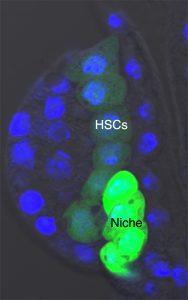The elusive hematopoietic stem cells of Drosophila.
Posted by LolitikaMandal, on 22 November 2016
Drosophila hematopoiesis shows striking resemblance with that of vertebrates, both at the level of signalling molecules and the phase of development. Even though there has been no report of Hematopoietic stem cells (HSCs) in Drosophila, this model has been employed extensively to understand progenitor biology and niche interactions. The Drosophila blood cells are specialised precursor cells (present within the hematopoietic organ: the lymph gland), that show several similarities with stem cells. They are known to differentiate into mature blood cells of the fruit fly. Our new study identifies the “founder cells” or the “stem cells” that give rise to these specialised blood-progenitors.
How it started off:
Our team was involved in detailed characterisation of signals which are required for the maintenance of the larval hematopoietic niche. To understand the dynamicity of the expression pattern of a battery of niche markers, we ventured into dissecting the larval lymph gland of the early first instar. Analysing a newly emerged larvae, about 8 hrs old, we encountered a group of large cells that always aligned themselves near the dorsal vessel or larval heart. We started calling them “Big Cells”. It turned out that these cells expressed several markers seen in other described stem cells.
Founder Cells or HSCs:
The very fact that they stood out almost every time in a early instar lymph gland caught our attention, and we felt tempted to characterise them. Our attempt to trace them throughout development revealed that although the “Big Cells” do not die, they could not be tracked beyond 22 hours post hatching. We argued that maybe they were changing their fate. Indeed, on lineage tracing of these cells and analysing them at various time point of development, we could see that they are actually converted to blood progenitor cells. Analysing the same genotype at mature third instar larval stages indicated that not only progenitors but also differentiated cells are lineage traced. This clearly indicates that the “Big Cells” are multi-potent in their nature. As a functional correlate, we genetically ablated the “Big Cells” and analysed the consequence on the mature lymph gland. Remarkably, the elimination of these 4-5 “Big Cells” drastically reduced the size of the gland.

The final climax:
At this point we were thrilled that we had a fine story to tell about the elusive founder cells of Drosophila lymph gland. But a stem cell story without niche is not complete! We therefore entered into a spree to nail down the niche and the signal. Our suspicion was on the already described progenitor niche known to maintain the precursor cells. Since this niche is specified in embryo and is the most differentiated cell type in the first instar lymph gland, we speculated that it might also be serving as the niche for the HSCs. Our expression studies demonstrated that HSCs are enriched in phosphorylated Mad (pMAD), a pathway effector of Dpp signalling. To start with, therefore, we down regulated pMad from the HSCs. This resulted in their disappearance and a concomitant reduction in lymph gland size. Strikingly, on knock down of Dpp signalling from the progenitor niche, the HSCs failed to self-renew, clearly validating that Dpp signalling from the progenitor niche is its source of sustenance. It is to be noted that vertebrate early HSCs are also maintained by BMP (vertebrate counterpart of Dpp) signalling.
What are the implications:
With the identification of the early HSCs and the signal that maintains in Drosophila larvae, we have not only demonstrated the conservation with vertebrates, but put forward a model that can be used for answering several questions pertinent to vertebrate early blood development, both in normal as well as aberrant conditions.
MAIN PAPER:
Dpp dependent Hematopoietic stem cells give rise to Hh dependent blood progenitors in larval lymph gland of Drosophila. 10.7554/eLife.18295
References:
Drevon, C., and T. Jaffredo. 2014. “Cell interactions and cell signaling during hematopoietic development.” Exp Cell Res 329 (2):200-6. doi: 10.1016/j.yexcr.2014.10.009.
Durand, C., C. Robin, K. Bollerot, M. H. Baron, K. Ottersbach, and E. Dzierzak. 2007. “Embryonic stromal clones reveal developmental regulators of definitive hematopoietic stem cells.” Proc Natl Acad Sci U S A 104 (52):20838-43. doi: 10.1073/pnas.0706923105.
Evans, C., Olson, J., Ngo, K., Kim, E., Lee, N., Kuoy, E., Patananan, A., Sitz, D., Tran, P., Do, M., Yackle, K., Cespedes, A., Hartenstein, V., Call, G., & Banerjee, U. (2009). G-TRACE: rapid Gal4-based cell lineage analysis in Drosophila Nature Methods, 6 (8), 603-605 DOI:10.1038/nmeth.1356
Evans, C.J., Sinenko, S.A., Mandal, L., Martinez-Agosto, J.A., Hartenstein, V., & Banerjee, U. (2007). Genetic Dissection of Hematopoiesis Using Drosophila as a Model SystemAdvances in Developmental Biology, 18, 259-299 DOI: 10.1016/S1574-3349(07)18011-X
Jung, S. H., C. J. Evans, C. Uemura, and U. Banerjee. 2005. “The Drosophila lymph gland as a developmental model of hematopoiesis.” Development 132 (11):2521-33. doi: 10.1242/dev.01837.
Mandal, L., Banerjee, U., & Hartenstein, V. (2004). Evidence for a fruit fly hemangioblast and similarities between lymph-gland hematopoiesis in fruit fly and mammal aorta-gonadal-mesonephros mesoderm Nature Genetics, 36 (9), 1019-1023 DOI: 10.1038/ng1404


 (5 votes)
(5 votes)